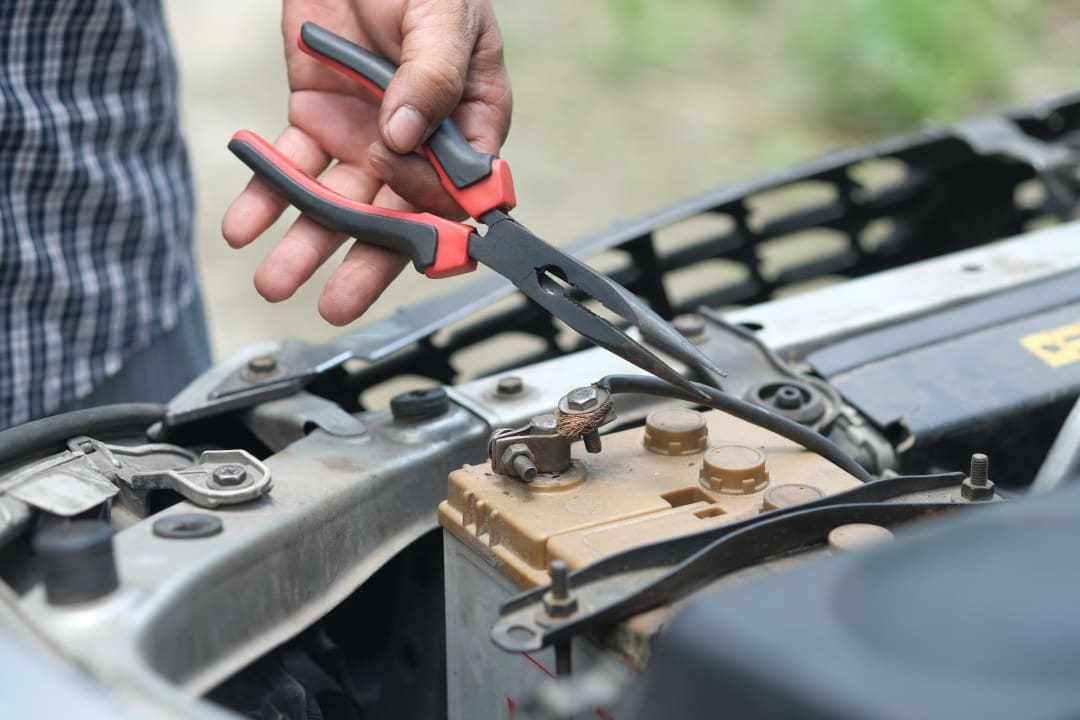
Maintaining Your Electric Vehicle Battery: Essential Tips for Longevity
September 20, 2023
Top Electric Tricycle Maintenance Tips for Rainy Weather
September 22, 2023Electric tricycles use rechargeable batteries for power and electric motors for propulsion. They are three-wheeled vehicles used for hauling goods or people. Electric tricycles adopt high-capacity tubular traction batteries that can withstand long periods of continuous discharge without reducing capacity after two years of normal use. The electric motors equipped are DC series wound brushed or brushless motors with built-in speed and power boosting devices, which are not easily damaged under normal use, ensuring strong output power.
Common Faults and Repair of Electric Tricycles Motors
Causes and solutions for electric tricycle motors running slowly: Measure the control handle high speed interface voltage, the output voltage should vary between 0.8-4.8V when rotating the handle, otherwise the handle is broken; use a multimeter in DC mode to measure power supply voltage, then measure motor voltage (with handle turned to max), if the voltage difference is over 1V then the controller is faulty and needs replacement; if abnormal noise occurs when motor is running, or motor housing overheats during riding, the motor is faulty; insufficient battery voltage can also cause slow speed (battery exceeded usage life or charging malfunction undercharged); design or manufacturing defects of the motor itself can lead to lack of power and slow speed, requiring motor replacement; carbon brush wear and tear also causes slow speed, requiring carbon brush replacement.
Insulation material life in electric tricycle motors is closely related to operating temperature. To ensure safe and reasonable use, monitoring and measuring windings, rotor and other parts’ temperature is necessary. According to national standards, motor windings of different insulation grades have different permissible temperature rises. Exceeding specified values, e.g. for Class B insulation, lifespan decreases by half for every 10 degrees increased. Therefore, accurate measurement of a component’s temperature during motor temperature rise testing is very important for improving motor design, manufacturing process and quality. Motor winding and other parts temperature measurement mainly uses resistance method, thermometer method, and embedded thermometer method.
Within a certain temperature range, the resistance of electric tricycle motor windings increases correspondingly with temperature rise, with a functional relation between resistance and temperature. Based on this principle, winding temperature can be determined by measuring resistance, known as resistance method. More advanced digital multimeters or microhm meters can be used for faster and more accurate DC resistance measurement if live measurement devices are unavailable.
Common electric tricycle faults include charger not charging, short single-charge range, speed control failure or unresponsive accelerator, motor malfunction, etc.
Charger not charging is due to loose plug connections, battery wiring disconnection, blown fuse, etc. Solutions are securing charger plug connections, re-soldering battery connections, replacing blown fuse.
Short single-charge range can be caused by: 1) insufficient battery charging 2) battery deterioration or damage 3) frequent braking, uphill reverse driving, heavy load. Solutions are: fully charge battery for insufficient charging; replace battery if deteriorated or damaged; use pedal assist for frequent braking, uphill reverse driving or heavy loads.
Speed control failure or unresponsive accelerator can be due to: loose speed control wire plug, loose magnet steel and steel wire rope connection in control handle, stuck or broken spring in handle. Solutions are: plug in wire plug, re-solder and clamp steel rope connection, repair or replace broken spring.
Motor malfunction can be caused by loose motor or battery wire plugs, loose or disconnected battery wiring, blown fuse in battery box. Solutions are: plug in loose plugs; re-solder and secure loose/disconnected wires; replace blown fuse.
For other faults like hub motor, controller, charger or battery pack anomalies that cannot be identified, consult dealers or authorized service stations, do not disassemble for self-repair, or product warranty may be voided.
Daily Use and Maintenance of Electric Tricycles
For safety, electric tricycle daily use and maintenance procedures are as follows:
The power switch should be opened when boarding and closed promptly when parking or pushing, to prevent accidental throttle rotation and sudden start. Pedal assist is recommended when going uphill.
Before riding, check battery box wire plugs for loose polarity seats, power switch flexibility, proper battery box locking, horn and light button effectiveness, light bulb status.
Adjust seat height so rider’s feet can touch the ground for safety.
Before riding, check battery case locking, display panel light status. Ride slowly through shallow water not exceeding hub motor center, otherwise water ingress may damage motor. Slightly heavier reverse and mild friction sound when pedaling forward are normal. Do not overload or carry excessive weight to avoid battery and motor damage.
Apply lubricating oil on drivetrain parts like front axle, mid axle, flywheel, front fork shock pivots every 6-12 months as needed. Check front/rear forks, handlebar, mid fork axle, rear shock absorber and fasteners monthly for looseness, consult local designated maintenance department for professional servicing if any looseness is found. Avoid using brakes and throttle simultaneously to prevent motor overload and damage to other components. Avoid bumpy or steep roads to prevent electrical contact failure from excessive vibration, dismount and push if encountered. Use pedal assist in winter when battery capacity decreases from low temperatures to prolong battery life for the same travel range. Immediately stop and pedal if motor continues running after releasing throttle, and consult professional maintenance department afterwards. Do not apply oil to brakes or tires.
Fully test electrical control circuits for faults, damaged wires and eliminate onsite. Adjust front and rear brakes for flexibility and reliability. Check handlebar steering reliability and for slack between handlebar and front fork. Check battery fluid level monthly in summer, 2-3 months in winter, and add distilled water if plates are exposed, never add acid as it will unbalance factory set electrolyte concentration and corrode plates, affecting battery life. Initial use requires adding gear oil to rear axle gearbox, subsequently check periodically for oil leaks, damaged seals, lack of lubrication, replace seals and top up oil as needed. Regularly lubricate gearbox and motor sprockets, chains, replace if excessively worn to avoid affecting use. Periodically tighten all bolts and check for looseness and rust, apply anti-rust agent to avoid seizing up. Thoroughly clean the vehicle.
Avoid storing in humid, high temperature or corrosive gas environments to prevent chemical corrosion of metal parts’ platings and paint. Avoid long-term sun exposure and rain to prevent control unit damage, malfunction and accidents. Do not dismantle or repair complex controller structures. Use AC voltage stabilizer if charger is unstable with mains fluctuations.
Lubricating the electric tricycle is essential maintenance. Lubricate front axle, rear axle, mid axle, flywheel, front forks, shock pivot points every 6-12 months as needed (lithium grease recommended). Transmission parts in hub motor have special lubricating oil applied, no additional lubrication needed. Consult authorized service centers for maintenance if abnormalities are found.
Electric Tricycle Daily Use and Maintenance Methods:
Adjust handlebar stem above fork stem safety line, adjust seat post above frame middle safety line. Avoid sun exposure and rain despite good water resistance, prevent rusting of body parts and rotary parts. Keep water level below wheel axle centerline when riding through water to prevent motor water damage. Front and rear brake operation should be smooth with spring rebound, brake handle gap from sleeve should be one finger wide, linings parallel with braking surface and evenly aligned.
Check brake power cut-off device intactness, prop up stand, open power switch, rotate right handle to start motor, then gently grip left brake lever – motor should cut power and gradually stop. If not, stop driving and consult professionals before further use. Inflate tires evenly till properly fitted to rims to avoid slippage.
Motor Disassembly and Maintenance: Disconnect motor wires from controller first and record wire colors for reconnection. Clean working area before opening end cap to prevent debris entering motor magnets. Mark end cap and hub positions before disassembly. Loosen screws diagonally to avoid housing deformation. The radial gap between rotor and stator is the air gap, normally 0.25-0.8mm, original end cap marks must be followed for reassembly to avoid flux scraping. Lubricate gear teeth fully with lithium grease no.3 or specified lubricating oil if increased noise occurs. For brushed motor reassembly, check brush spring tension, no friction with holder, full range of motion, correct brush and commutator alignment to avoid jamming.
Full electric tricycle maintenance includes checking bolt and nut tightness, control performance, tire wear, mechanical system condition, battery capacity, brushed motor annual maintenance.
Charger Fault Repair Procedures and Methods
Double-ended electric tricycle charger fault repair steps and methods are as follows:
Step 1, visually inspect for blown fuse, switch tube, resistor discoloration, cracks, capacitor swelling, electrolyte leakage, false soldering on circuit board.
Step 2, use resistance method to measure circuit and component resistance, focusing on checking power supply rectifier diodes VD1-VD4 and switch tubes V1, V2. Measure V1, V2 base circuit resistance and capacitor values, diode forward and reverse resistance. Compare V1, V2 base circuit resistances for consistency to identify faulty components.
Step 3, apply +20V DC power to pulse width modulation IC power pins (C19 legs), observe 50kHz square wave output from output pins, if absent then TW94 is damaged, otherwise PWM IC is normal. Next measure push-pull driver (V3, V4) collector square waveforms. Distortion or inconsistency indicates V3, V4 damage, consistent square waves mean push-pull driver circuit is normal. Finally measure V1, V2 base waveforms, if abnormal then components VD5 (VD8), R4 (R11), R6 (R8), C9 (C10) may be damaged, further measurements needed after disassembly to confirm faulty component.
Step 4, switch conversion circuit safe repair method: Remove PWM circuit external power supply, connect low-voltage ~40V AC supply to mains input. Rectifier circuit outputs >40V DC indicating no switch tube short circuit faults; if no or low voltage output, then blow fuse FU1, rectifier diodes VD1-VD4, capacitors C7, C8, switch tubes V1, V2 are damaged. Remove and measure resistances to confirm faulty component.
With rectifier output normal, connect PWM +20V DC and main 40V AC supplies, measure switch tube V1 emitter and transformer T3 7, 8 pin waveforms while feeling V1, V2 temperature. Distorted waveforms or excessive V1, V2 heating indicates faults. Normal waveforms and temperatures, measure secondary rectifier +40V output (across C21) which should be 9V, indicating circuit is basically normal. Remove external supplies and test with mains power.
The step-by-step repair process for switch mode chargers is complex but safe and reliable. Hidden faults may damage components instantly on power-up after repairing high voltage pulsed switch mode chargers. This protective method is safe, reliable in detecting hidden faults without damaging components, and also applicable to repairing other inverter switch mode power supplies.
Typical Electric Tricycle Fault Repair
Common electric tricycle fault repairs are as follows:
Brushed motor fails to start due to open circuits like winding disconnect, winding to commutator disconnect, loose brush terminal, ineffective spring pressure, worn brushes or commutator. Use multimeter or milliammeter to measure commutator segment resistances, faulty segments will read differently from others. Fix probes in place and move the other probe around, pointer fluctuations indicate disconnected coil of that segment; constantly high readings mean probe contact segment is shorted. Use milliammeter below 3V, zero or minimum readings indicate open circuit. Check winding terminals to segments for cold solder joints, movement or separation with probe scraping indicates bad joint, simply resoldering repairs. Internal shorted winding repairs are difficult, if only 1-2 discontinuities, shorting segments may work; if multiple discontinuities, rewinding may be necessary; 1-2 disconnected coils may still run but with reduced speed, torque and performance instability. Gradually worsens as more coils disconnect until motor cannot start.
Single cell battery open circuit. Among battery faults, there is a phenomenon between complete disconnect and normal conductivity called sub-cell open circuit fault, usually caused by manufacturing defects with the following characteristics:
Normal voltage when measured, small load discharge normal but large load discharge fails, only small current discharge works.
Trickle charge current with standard charge voltage, no increase when input voltage raised, current reading unchanged despite disconnecting input.
No obvious open circuit cross section unlike fully open cells. Fault mostly due to sulfation weakly connecting conductors, caused by cracks, cold joints or acid contamination during production assembly, forming insulating non-conductive oxides when battery is used. Current flows during light load but blocking large currents, explaining some batteries working normally until failing to deliver high start-up currents.
Sub-cell open circuit faults are easy to detect, “faulty” sections heat up abnormally during charging due to partial conductivity, and white smoke from vent caps when voltage increased. Plastic tube listening can distinguish fault cell sounds from normal cells. Prior to complete disconnection, aquaeous vent cap topping up fluid turns opaque white from lead sulfate compounds, insoluble in water.
Motor Bearing Fault Inspection and Repair: Shaft rotations supported by bearings are heaviest loaded and prone to wear.
Inspection while operating: Insufficient lubrication can be judged from abnormal noise, indicating possible bearing fracture. Foreign debris also causes noise.
Inspection after disassembly: Check for bearing wear, then grip inner race horizontally and push outer race – good bearings spin smoothly without vibration or jamming, and do not reverse after stopping, indicating replacement needed. Easily spun by left hand bracing outer race and right hand gripping inner race signifies severe wear.
Repair: Remove rust with sandpaper and apply gasoline, or replace if cracked or excessively worn. Ensure replacement bearings are correctly specified.
Shaft Repair: Minor bends can be mechanically straightened by grinding, major bends exceeding 0.2mm straightened by press machine before grinding smooth. Badly bent shafts need replacement. Minor wear can be plated then ground to size, badly worn shafts weld-repaired before grinding to specifications. Consider replacement if wear exceeds repair limits. Transverse cracks up to 10-15% of diameter and longitudinal cracks up to 10% of length can be welded then ground to standards, otherwise replace for excessive cracking or breakage.
Housing and End Cap Repairs: Excessive housing-cap gaps can be welded then ground smooth, loose end cap fits can be peened before reinserting bearing and end cap. High power motors may require plating. Routine maintenance through inspection and prompt abnormality root cause removal is crucial to avoid motor operation faults. Thorough failure analysis and countermeasures reduce incidents and repairs, also improving efficiency.
Electric motors are now widely used on electric tricycles, in industrial, mining and agricultural applications. Recognizing the importance of motor maintenance helps organizations and consumers economically and safely generate greater value.

